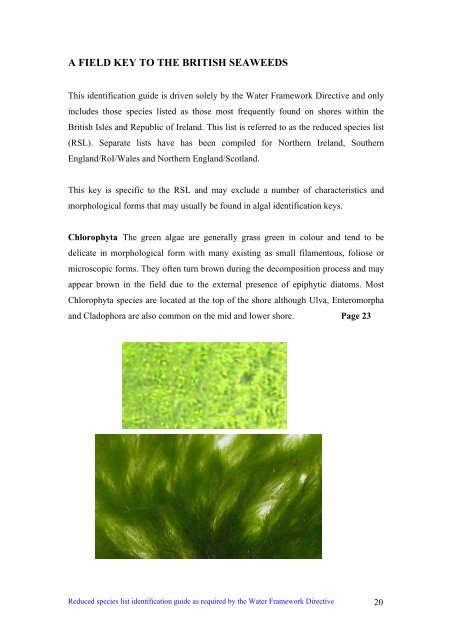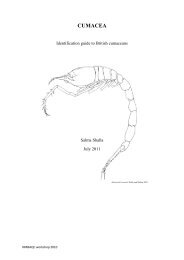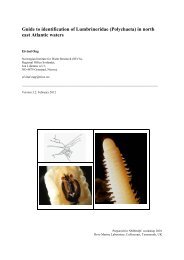s A Field Guide to the British Seaweeds - NMBAQC
s A Field Guide to the British Seaweeds - NMBAQC
s A Field Guide to the British Seaweeds - NMBAQC
Create successful ePaper yourself
Turn your PDF publications into a flip-book with our unique Google optimized e-Paper software.
A FIELD KEY TO THE BRITISH SEAWEEDS<br />
This identification guide is driven solely by <strong>the</strong> Water Framework Directive and only<br />
includes those species listed as those most frequently found on shores within <strong>the</strong><br />
<strong>British</strong> Isles and Republic of Ireland. This list is referred <strong>to</strong> as <strong>the</strong> reduced species list<br />
(RSL). Separate lists have has been compiled for Nor<strong>the</strong>rn Ireland, Sou<strong>the</strong>rn<br />
England/RoI/Wales and Nor<strong>the</strong>rn England/Scotland.<br />
This key is specific <strong>to</strong> <strong>the</strong> RSL and may exclude a number of characteristics and<br />
morphological forms that may usually be found in algal identification keys.<br />
Chlorophyta The green algae are generally grass green in colour and tend <strong>to</strong> be<br />
delicate in morphological form with many existing as small filamen<strong>to</strong>us, foliose or<br />
microscopic forms. They often turn brown during <strong>the</strong> decomposition process and may<br />
appear brown in <strong>the</strong> field due <strong>to</strong> <strong>the</strong> external presence of epiphytic dia<strong>to</strong>ms. Most<br />
Chlorophyta species are located at <strong>the</strong> <strong>to</strong>p of <strong>the</strong> shore although Ulva, Enteromorpha<br />
and Cladophora are also common on <strong>the</strong> mid and lower shore. Page 23<br />
Reduced species list identification guide as required by <strong>the</strong> Water Framework Directive 20




